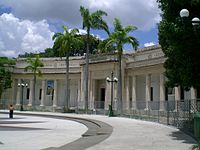
Photo from wikipedia
Abstract This study proposes a mesoscopic thermo-mechanical (TM) lattice model to describe the transient thermal strain (TTS) behaviour of concrete and to predict the attenuation of its TM properties as… Click to show full abstract
Abstract This study proposes a mesoscopic thermo-mechanical (TM) lattice model to describe the transient thermal strain (TTS) behaviour of concrete and to predict the attenuation of its TM properties as a function of temperature. In such a model, concrete includes three constituents: cement, aggregates and interfacial transition zones (ITZ). A damage model including softening behaviour is used to describe the behaviour of the cement matrix and the ITZ, while the aggregates are assumed to be elastic. The thermal response within mesoscopic concrete is represented by a non-linear heat transfer equation, where the mechanical effect on thermal conductivity is taken into account. Mismatch of thermal expansions and stiffness between material phases (cement, aggregate) causes damage of concrete subjected to thermal and/or mechanical loadings, which makes decrease the concrete properties. Five parameters are envisaged: Young's modulus, compressive strength, direct tensile strength, thermal conductivity and thermal expansion coefficient. TM responses of concrete, especially TTS phenomenon and evolution of some key properties appear to be captured by the proposed mesoscale TM model (without consideration of moisture effects). Comparisons with experimental studies are drawn through this paper to show the ability of the present model.
Journal Title: Fire Safety Journal
Year Published: 2020
Link to full text (if available)
Share on Social Media: Sign Up to like & get
recommendations!